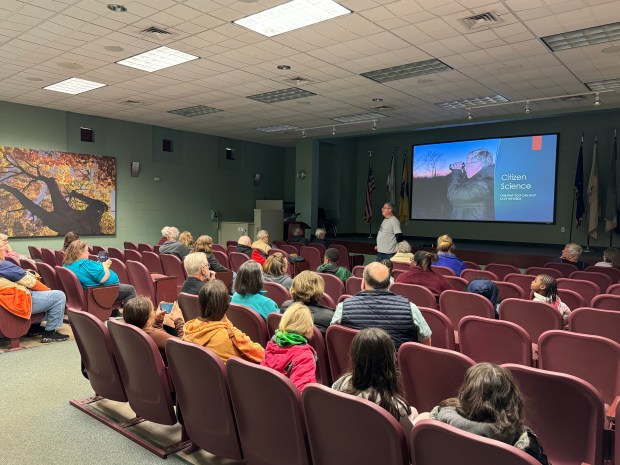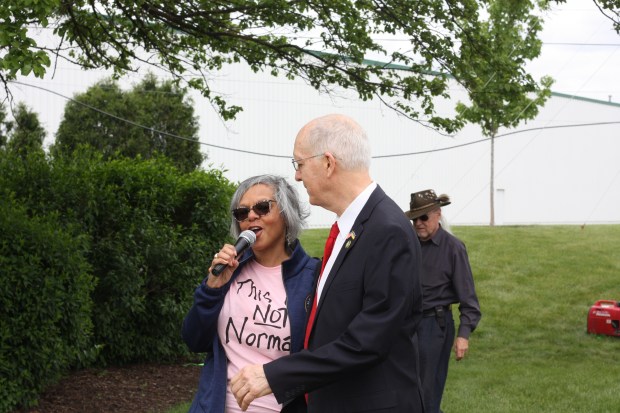North America is losing bird populations and while humans have a lot to do with that loss, they can work to reverse it, too, particularly at the Indiana Dunes.
That was the message during Science Friday at the Indiana Dunes for April in a talk by Dan Barriball, an interpretive naturalist with Indiana Dunes State Park, who discussed using citizen science to save birds at the dunes.
About 80 people of all ages gathered at the Indiana Dunes Visitor Center to hear Barriball’s talk.
“In 2019, the Cornell Lab of Ornithology and the American Bird Conservancy released a major study on all the birding data that they had available until today, and what they found was that North America has lost 2.9 billion birds in that 50 years,” said Barriball, of Chesterton.
“There are a lot of reasons for that. All of them having to do with how humans have altered the environment,” said Barriball. “That decline is across every biome.”
“Every major bird family have suffered loss,” said Barriball, noting charts of finches, sparrows and warblers showing that they have declined significantly, along with America’s favorite feeder birds like rose-breasted grosbeaks, blue jays and Baltimore orioles.
“The situation is kind of dire, but it is not hopeless,” said Barriball.
“There has been some good news over the last 50 years, too,” said Barriball. “Various species of waterfowl have increased by 50% and turkeys have gone up over 200%, but in every case of those recoveries, there is a common theme because humans took some effort to save these birds.”
“The situation is not hopeless, but we need to take effort so that we have birds going forward,” said Barriball.
The National Audubon Society has seven recommendations to help birds, including using native plants, avoiding pesticides, keeping cats inside, and even drinking shade-grown coffee.
“The vast majority of the occurrence of birds out there is recorded by the eyes and ears of birders who are not scientists, such as myself,” said Barriball, who is on the board of the Dunes-Calumet Audubon Society and it a part of much of the citizen science occurring at the Indiana Dunes.
Their efforts include a great blue heron nest watch, which nests in trees.
“Northwest Indiana, at the time of European settlement, had a lot of wetlands,” said Barriball. “We have unfortunately drained a lot of those but we still have a lot of wetlands here and the herons make use of them.”
“We stop at a wetland and look for the nests up in trees,” said Barriball. “And we see if we find a heronry.”
“We look for the chicks in the nest, we count them the best we can, and we go to the site three times,” said Barriball. “We are trying to find out where herons are actively nesting because as an area goes through ecological succession, the site may become more or less favorable for herons.”
Another citizen science effort at the dunes is northern saw-whet owl banding.
“They are little owls about the size of robins,” said Barriball. “Since 2009, Project Owlnet has been active here in the Indiana Dunes catching the owls, banding them and releasing them.”
“What we are hoping happens is that owl with the band on it has an identity and we will be able to tell where that bird has been if we catch it again,” said Barriball.
“The project is carried out here by the Indiana Audubon Society with a lot of participation from the Dunes-Calumet Audubon Society as well,” said Barriball.
“Our usual way of monitoring birds and going out into the woods does not work for owls because we are not going to see them during the day,” said Barriball. “Before Project Owlnet, we knew very little about their migration.”
After Barriball took questions from the audience, he also taught attendees about some free apps to use when they are out hiking to identify birds through pictures and sounds.
These apps include eBird, or the National Audubon app, which are similar to the field guide books that birders carried with them in the past, and Merlin, sponsored by Cornell University, which can help record and identify bird calls.
Francine Stafford, of New Jersey, attended the talk with her children, Troy, 12, Abigail, 8, Caroline, 7, and Isabelle, 5, all of whom asked Barriball questions. The Staffords were visiting Chicago but spent the day at the dunes.
“I went to Cornell University, so I was very interested in all he had to say about the studies and apps available,” said Stafford.
Cheyenne Clutterhan, of Highland, came to the talk with her five children, whom she homeschools.
“We do a lot of these programs but this is our first one here at the dunes,” said Clutterhan. “It was great.”
“They (my children) always learn a little more in person than they can with a book, and they can connect more that way,” said Clutterhan, adding she was intrigued by the owl-banding information.
To get involved with Barriball’s organization or learn more about becoming a birder, visit www.dunescalaudubon.org.
Deena Lawley-Dixon is a freelance reporter for the Post-Tribune.




